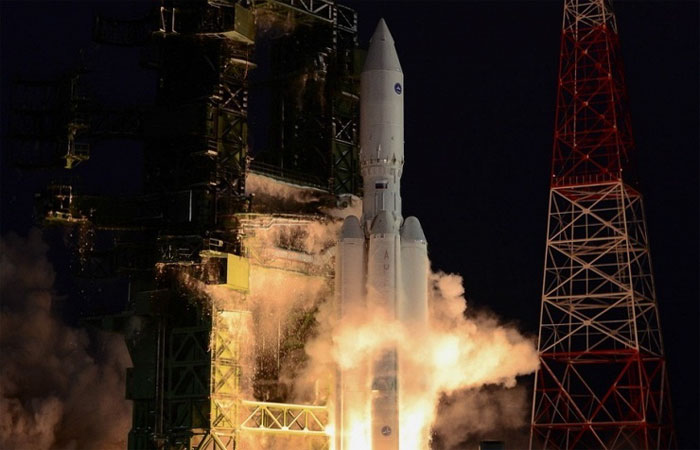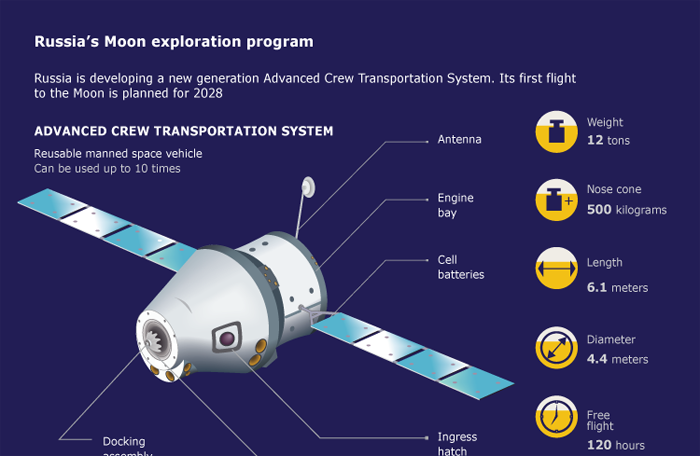.

Russian manned mission to Moon to require up to six Angara rocket launches — source
-
According to the source, the launches are planned to be carried out in pairs from the Vostochny cosmodrome and the Plesetsk cosmodrome with small intervals between the blast-offs
.
The organisation of Russia’s manned mission to the Moon will require from four to six launches of the Angara-A5V heavy-lift carrier rocket from the Plesetsk and Vostochny spaceports, a source in the rocket and space industry told TASS on Monday.
According to the source, a manned flight to the moon is possible under a scheme envisaging two coupled launches. First, a lunar take-off and landing complex is placed on a low Earth orbit, and then the upper stage with effective cryogenic propellants is orbited. The third launch orbits a manned spacecraft, and the fourth - another upper stage. After docking of the lunar take-off and landing complex with the manned spacecraft on the lunar orbit, the crew descends to the Moon surface inside the lunar take-off and landing complex, carries out the research program and returns to orbit. After that the spaceship returns to Earth.
Also, another coupled Angara-A5V launch will be needed before the manned flight to deliver and deploy the first expeditionary unit of the lunar base on the Moon.

"Thus, Russia’s first full-fledged expedition to the Moon would require six launches of the Angara-A5V rocket," the source said.
Previously, head of the Energia Rocket and Space Corporation (RKK Energia) Vladimir Solntsev said that the flight to the Moon would require four Angara launches.
According to the source, the launches are planned to be carried out in pairs from the Vostochny cosmodrome (the Amur region in Russia’s Far East) and the Plesetsk cosmodrome (Archangelsk region in the northwest) with small intervals between the blast-offs. Under the proposed scheme, after the orbit placement, the complex with a total weight up to 70 tonnes will be docked with the manned spacecraft, after which it will fly to the Moon. A payload of 18-20 tonnes will be delivered to the lunar orbit by the end of the mission.
According to a preliminary plan, Russia’s first manned flight to the Moon is possible in 2029. One year ahead of that it is planned to conduct a flight around the Moon, the testing and qualification of space systems for the future manned landing. However, this project may become a reality only if the work to create a new-generation manned transport spacecraft, the Angara-A5 rocket, lunar boosters and other needed rocket and space technology and infrastructure is included in the draft Federal Space Program for 2016-2025.
In September, Russia’s Federal Space Agency Roscosmos announced that it will send a lander, Luna 25, to the Moon's south pole in 2024. After touchdown, the lander will investigate the lunar surface for future lunar bases. The Luna 25 mission was initially proposed in 1997 and has since suffered a number of delays, but it seems that with Europe's aid the mission could finally get the jump-start it needs. Construction of the spacecraft has already begun.
Russian Space Research Institute (IKI) has recently revealed details about the upcoming Luna 25 (also known as Luna-Glob lander) mission that is being developed by the institute. The Luna 25 mission will include instruments that will carry out scientific research on the lunar surface and deliver detailed data about the Moon’s composition. The IKI-made instruments - such as LIS-TV-RPM (providing IR spectrometry of minerals, and TV imaging) and PmL (responsible for studying the lunar dust and micrometeorites) - will be supported by tools developed in collaboration with universities in Sweden and Switzerland. The probe will also feature the ADRON-LR instrument that will make active neutron and gamma-ray analysis of regolith. Another significant payload, ARIES-L, will measure the Moon’s exosphere plasma. The mission is included in the Federal Space program of Russia for 2016-2025. The launch of the Luna 25 spacecraft is currently planned for 2024. The continuation of the Luna program could be the beginning of Russian plans to establish a lunar base sometime in the 2030s. The proposed base would include a solar power station, telecommunication station, technological station, scientific station, long-range research rover, landing and launch area, and an orbiting satellite.
.

Quelle: TASS
4535 Views
